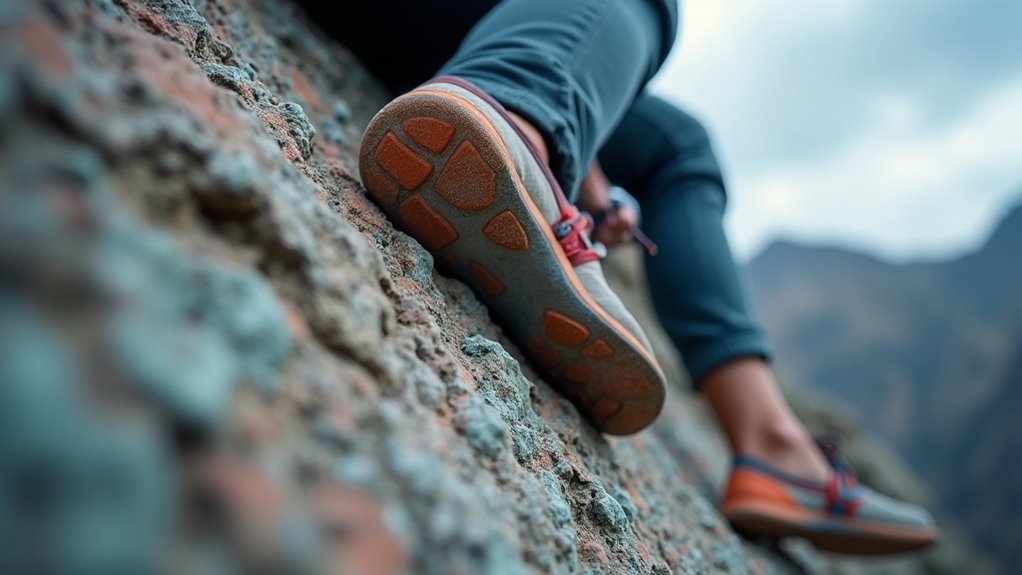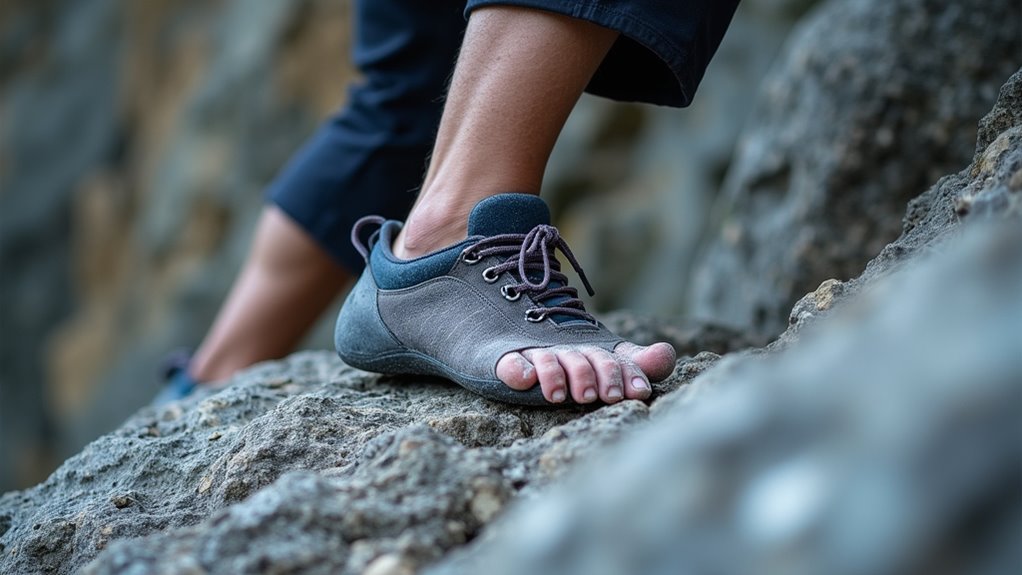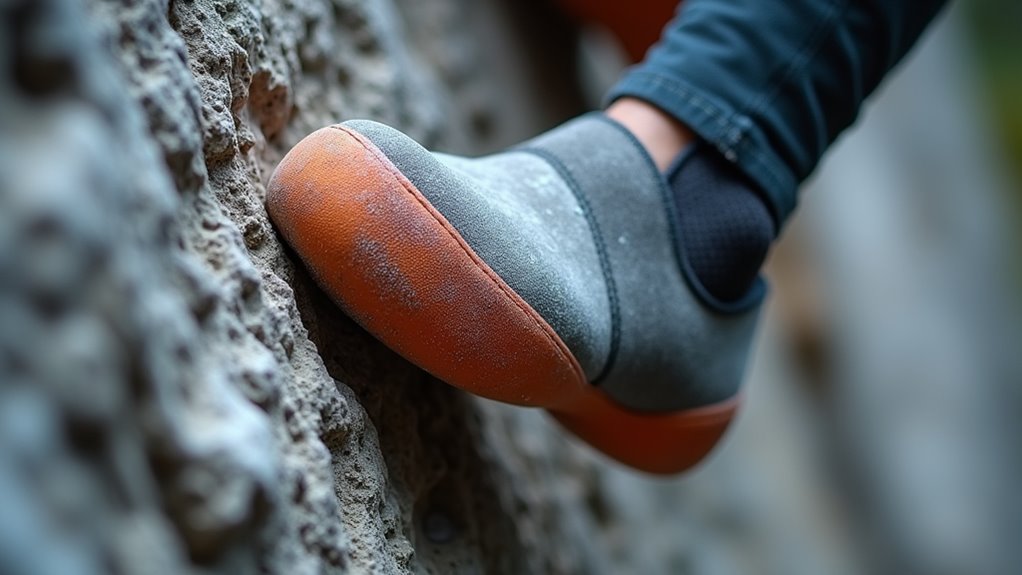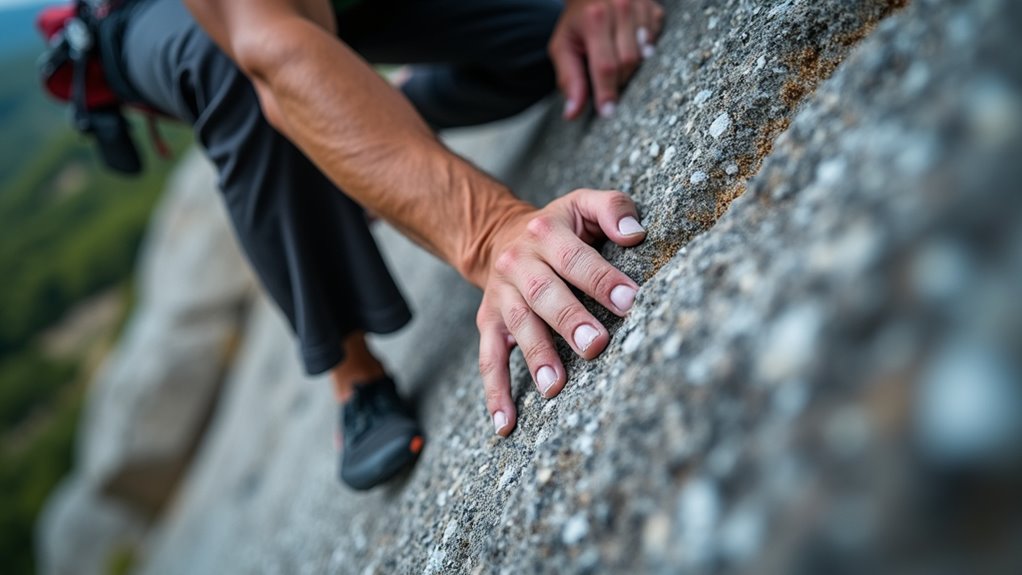Physical Address
304 North Cardinal St.
Dorchester Center, MA 02124
Physical Address
304 North Cardinal St.
Dorchester Center, MA 02124

Struggling with pumped forearms while watching others effortlessly glide up routes you can barely finish?
You’ve probably watched experienced climbers glide up routes that leave you pumped and struggling, wondering what magic they possess that you don’t. The secret isn’t superhuman strength or flexibility—it’s footwork. While you’re death-gripping holds and burning out your forearms, they’re dancing up the wall with calculated precision. Master these seven fundamental techniques, and you’ll discover how proper foot placement transforms climbing from an exhausting battle into an elegant conversation between you and the rock.

When you’re staring down at a tiny foothold, doubt creeps in fast. Your brain starts questioning whether that small edge can actually support your weight. Here’s the truth: hesitation kills your footwork more than anything else.
Stop second-guessing yourself and commit fully to each step. When you place your foot on a hold, trust it completely. Half-hearted foot placements create wobbles and slips that wouldn’t happen with confident commitment.
Practice deliberate foot placement on easier routes. Look at each foothold before stepping on it, then commit without looking back. Your feet are stronger and more precise than you think.
Build this trust gradually. Start with obvious footholds, then progress to smaller ones. Soon you’ll discover that confident foot placement transforms your entire climbing experience.
This principle applies whether you’re tackling challenging rock faces or simply enjoying outdoor activities during different life phases when balance and confidence become even more crucial.
Confident footwork goes hand-in-hand with quiet, controlled movement. When you slam your feet onto holds, you’re wasting energy and losing precision. Instead, practice placing each foot deliberately and silently on the rock.
Listen to your footwork as you climb. Scraping, banging, and readjusting sounds indicate sloppy technique. Aim for whisper-quiet placement by controlling your leg muscles throughout the entire movement.
Your ears are the best judge of footwork quality—noisy feet reveal poor technique while silent placement shows mastery.
Lower your foot slowly onto the hold, making contact with intention rather than hope. This deliberate approach forces you to engage your core and maintain better body positioning.
You’ll naturally become more aware of hold quality and foot placement options. Silent footwork also prevents you from alerting your belayer to every struggle, keeping your climbing smooth and confident-looking.
Mastering this quiet technique becomes especially valuable when rock climbing during camping trips where you want to minimize noise and maximize your connection with the natural environment.

Most climbers default to using their big toe or the front of their shoe, but your inside edge offers superior precision and power. This technique engages your entire foot’s arch, creating a stronger connection with the rock.
Position the inside edge of your shoe along the hold, from your big toe to mid-foot area.
Practice edging on small footholds by rotating your ankle inward and pressing firmly. You’ll notice increased stability and control compared to toe-only placement.
The inside edge works particularly well on vertical walls and overhangs where you need maximum grip.
Start incorporating this technique on easier routes until it becomes natural. Your calves might feel tired initially, but you’ll develop the necessary strength and flexibility with consistent practice.
Mastering proper footwork techniques like inside edging is one of the essential climbing safety practices that can prevent slips and falls on challenging routes.
While proper foot placement sets the foundation for good climbing technique, your hip positioning determines how effectively you can use that footwork. Keep your hips pressed close to the wall to maximize your balance and reduce strain on your arms.
When you lean away from the rock, you’re fighting gravity and forcing your hands to work overtime.
Think of your hips as your center of gravity. Position them directly over your feet whenever possible. This creates a stable triangle between your two feet and hips, giving you better control.
You’ll notice immediate improvements in your endurance since your legs will bear more weight instead of your arms.
Better hip positioning instantly boosts climbing endurance by shifting weight from overworked arms to your stronger leg muscles.
Practice this by consciously pushing your hips toward the wall during each move. Mastering this hip positioning technique is one of the expert tips that transforms average climbers into more efficient and confident athletes.

Before you reach for the next handhold, scan the rock below for your next foot placement. Most climbers make the mistake of looking up constantly, fixated on their destination. This upward focus creates poor footwork habits and wastes energy.
Instead, develop a rhythm: look down, plan your foot sequence, then execute your move. You’ll spot holds you’d otherwise miss and avoid the dreaded “Elvis leg” from poor positioning. Your feet should move with intention, not desperation.
When you’re pumped and rushing, this downward scan becomes even more critical. Take that extra second to examine your options. Quality foot placement trumps speed every time. Your forearms will thank you, and you’ll climb more efficiently.
Smart footwork starts with looking where your feet need to go. Just like campers who enjoy water activities for a refreshing break, climbers can benefit from incorporating water-based training exercises to improve balance and footwork precision.
After you’ve mastered spotting your next foot placement, you’ll need techniques to maintain balance when good footholds aren’t available. Flagging involves extending your outside leg away from the wall to counteract rotational forces. When reaching across your body, flag your opposite leg behind you or to the side. This creates stability and prevents barn-dooring off the wall.
Counter-balance works by positioning your body weight opposite to your reaching direction. If you’re stretching right, shift your hips left and engage your core. Practice these techniques on easier routes first. Start with simple flags during traverses, then progress to dynamic movements. Proper flagging and counter-balance techniques are essential for preventing climbing injuries that commonly occur when climbers lose balance and fall awkwardly.

Once you’ve developed your flagging skills, the three-point contact rule becomes your safety net and stability foundation. This fundamental principle means you’ll always maintain contact with the rock using three of your four limbs while moving the fourth to the next hold.
When reaching for a new handhold, keep both feet planted and your supporting hand firmly gripped. Similarly, when stepping up, ensure both hands stay secure while only one foot moves. This creates a stable triangle that prevents sudden falls and reduces muscle fatigue.
Don’t rush between holds. Take time to establish solid contact before switching. Your grip strength will last longer, and you’ll climb more efficiently. Practice this technique on easier routes until it becomes second nature—your body will thank you.
These climbing fundamentals become especially valuable when you’re exploring incredible destinations that offer both challenging rock faces and scenic hiking trails for a complete outdoor adventure.
Your feet are your foundation on the rock – treat them like gold. By mastering these seven techniques, you’ll transform from a climber who fights the wall to one who dances with it. Remember, great footwork isn’t built overnight, so be patient with yourself as you practice. Start with easier routes and gradually work up. Soon, you’ll find yourself moving with confidence and grace, making every climb feel more controlled and enjoyable.